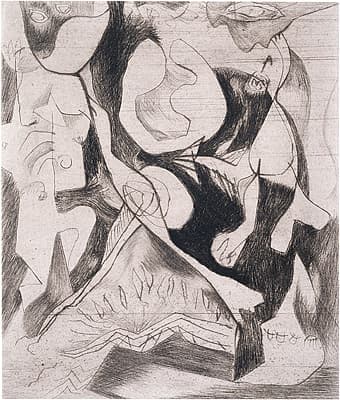
Jackson
POLLOCK
United States of America
1912
–
1956
Untitled: from Suite of six intaglio prints
c.1944
intaglio, engraving and drypoint
2/50
Part of a suite of 6 prints postumous edition of 50 printed by Emiliano Sorini
Dry-stamp mark of the Estate of Jackson Pollock
OT1071
51.0 (h)
x 34.8 (w)
cm
framed
74.2 (h)
x 54.7 (w)
cm
Purchased 1984
National Gallery of Australia, Canberra
NGA 1984.1176.1
© Pollock/Krasner Foundation/ARS. Licensed by Viscopy
- The Spontaneous Gesture
- National Gallery of Australia 06 Jun 1987 – 13 Sep 1987
- Jackson Pollock's Blue poles
- National Gallery of Australia 04 Oct 2002 – 27 Jan 2003
The prints that Pollock made in the mid-1940s played a critical role in developing his late style. From late 1944 until early 1945 he worked at Atelier 17, the workshop established by Stanley William Hayter in New York City, where Robert Motherwell, Willem de Kooning, Mark Rothko and others also made prints. Eleven plates were engraved and printed at this time. Six of these were later restored and published posthumously by Pollock’s widow, Lee Krasner, in conjunction with the Museum of Modern Art, New York.
These intaglio works show Pollock’s transition from Surrealism to an Abstract Expressionist mode, under a range of influences including Picasso, tribal art and Jungian psychology. While the earlier compositions of outlines and twisted figures reveal the continuing impact of Picasso, Miro and Klee, the later, landscape-format works show a complex tangle of figures within an ambiguous space. The second largest print is the best known of the suite: this dynamic work is activated by a tall and powerful figure at the extreme left of the composition. Standing in front of a large crowd, which seems to dissolve in darkness and light, the figure has been likened to a shaman or spirit totem merging with its tribe.[1]
Lucina Ward
[1] See, for example, Lanier Graham, The spontaneous gesture: Prints and books of the Abstract Expressionist era, Canberra: Australian National Gallery 1985, p. 8
Discussion of the work
The prints that Pollock made in the mid-1940s played a critical role in developing his late style. From late 1944 until early 1945 he worked at Atelier 17, the workshop established by Stanley William Hayter in New York City, where Robert Motherwell, Willem de Kooning, Mark Rothko and others also made prints. Eleven plates were engraved and printed at this time. Six of these were later restored and published posthumously by Pollock’s widow, Lee Krasner, in conjunction with the Museum of Modern Art, New York.
These intaglio works show Pollock’s transition from Surrealism to an Abstract Expressionist mode, under a range of influences including Picasso, tribal art and Jungian psychology. While the earlier compositions of outlines and twisted figures reveal the continuing impact of Picasso, Miro and Klee, the later, landscape-format works show a complex tangle of figures within an ambiguous space. The second largest print is the best known of the suite: this dynamic work is activated by a tall and powerful figure at the extreme left of the composition. Standing in front of a large crowd, which seems to dissolve in darkness and light, the figure has been likened to a shaman or spirit totem merging with its tribe.[1]
Lucina Ward
[1] See, for example, Lanier Graham, The spontaneous gesture: Prints and books of the Abstract Expressionist era, Canberra: Australian National Gallery 1985, p. 8
